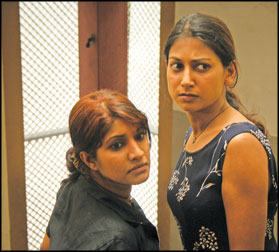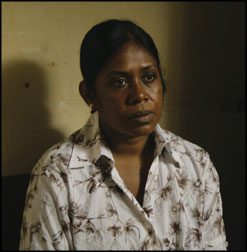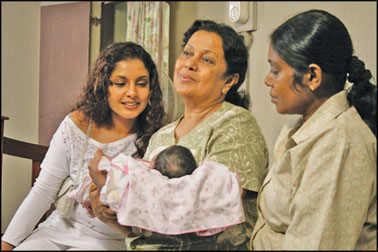|
Review:
Akasa Kusum (Flowers of the sky):
Cinematic reality of personal tragedy
By Indeewara THILAKARATHNE and Ranga CHANDRARATHNE
|

Nimmi Harasgama brilliantly portrays the character of Priya,
Sandhya Rani’s daughter born out of wedlock.
|
Akasa Kusum (Flowers of the sky) which was written and directed by
Prasanna Vithanage is one of the best films that contemporary Sri Lankan
cinema has made. Set against the globalised milieu, Prasanna masterly
explores the Sri Lankan filmdom through a tragic character of one time
popular icon Sandya Rani, portrayed by Malini Fonseka.
Though the film is seen as a mere tragic tale of a film icon of the
bygone era at a superficial level, Prasanna with his impressive
cinematic diction touches on several social issues such as abortion,
extra -marital affairs and the overarching influence of globalisation
particularly on the urban population. One of the salient characteristic
of Prasanna’s cinema is that his ability to imbed myriad of social
issues in his films as a sub-text.
From the very first frame of the film, the effect of globalisation is
clearly manifested; Sandhaya Rani, the lead role of the film, who leads
an isolated life, reads a letter from Canada. Sandhya Rani’s relation in
Canada requests her to migrate. However, she declines the offer. The
focus is shifted, then, on to the surrounding of the ordinary house in
which the one time famed film star lives with a cat. Though it seems
insignificant, the somewhat detailed description of Sandhya Rani’s
character, the house and her mannerism, serve to convey an idea of her
past. Her only source of income seems to be from selling of patties and
renting out a room to young film and soap opera actors for their
extra-marital affairs.
The occasional appearance of her sister Mallika (Kaushalya Fernando)
with the intention of obtaining money, perhaps, never to be returned,
would also, in a way, reminds Sandhya Rani’s socio-cultural background.
The economic hardships of that class from which Mallika comes, is subtly
conveyed through Mallika’s attire and her mannerism. Though Mallika
looks down on the act of renting out the room to young film and soap
opera actors to satisfy their sexual desires, she accepts money when
offered by Sandhaya Rani.
|

Nimmi Harasgama as Nimmi Harasgama (Priya) with Samanalee
Fonseka (Bunty) in a scene. |
The story unfolds with the young popular film star Shalika (Dilhani
Ekanayake) starts to use the room to carry on an extra-marital affair
with an actor. However, Shalika’s husband Eric (Mohamed Adamaly)
discovers the affair compelling Shalika to live with Sandhya Rani.
Having her husband left, Shalika persuades Sandhya Rani to make a
comeback. Though Sandhya Rani’s fans are thrilled to see her, once again
in the lime light, it leads Sandhya Rani to confront the dark-side of
her character which is well buried and forgotten by the time.
Her daughter Priya (Nimmi Harasgama), born out of wedlock and was
forced to abandon as an infant, is an attractive woman working in a
Karaoke night club as a hostess. She is three months pregnant and
infected with HIV. Having seen Sandhya Rani on television, she conveys
to her, avoiding a face-to-face meeting, that she exists and that
Sandhya Rani is responsible for her plight.
However, the revelation disturbs Sandhya Rani’s life as never before.
Cinematography
|

Kaushalya Fernando as Mallika with a monkey –like face portraying
brilliantly a rustic village girl. The character reminds her
earlier role as a female garment factory worker in Satyajith
Maitipe’s Borediya Pokuna (The Lotus Pond). |
Akasa Kusum, among other things, is not a clear departure from
Prasanna’s typical narrative style and the diction. His grammar of
cinema from his very first film Sisila Gini Gani (Ice on fire) has been
precise. Here in Akasa Kusum, narration takes place in a slow moving
rhythm sychoronised with the story line. Almost every frame of the film
seems essential for the story; even seemingly insignificant shots such
as those of the cat and the car parked in the courtyard of the house and
those on the interior and exterior of the house, are, in a way, central
to the theme.
However, the significant aspect of Akasa Kusum is Prasanna’s ability
to take globalised milieu as a launching pad of the story. Through the
character of Sandhya Rani, Prasanna drives home the harsh reality of the
Sri Lankan filmdom; Sandhya Rani, once queen of the cinema, over the
years, becomes a relict of the past, forgotten by her fans.
In a globalised milieu, actor’s success is more or less determined by
the market forces and on the ratings of the film or soap operas. In a
way, Akasa Kusum offers an overview of effects of globalisation on the
life style of the people; urban subculture or night clubs and Karaoke
clubs, sex workers and urban shanties flourish along with influential
soap opera industry and mega teledramas. The quality of the soap opera
industry is manifested by the fact that when Sandhya Rani wanted to quit
the mega series, the director asks her for time to kill the character.
Although Akasa Kusum is one of the best productions, the director,
other than offering an overview of a tragic life story of Sandhya Rani,
has failed to evolve any character to a logical conclusion. For
instance, even the lead character of the film, Sandhya Rani, though
biographical in a particular context has not been evolved.
The technique of flash back which is used to portray the childhood of
Sandhya Rani has not been effective. Over use of scenes such as Karaoke
club, scenes from soap opera and the television feature programme, in a
way, suggest that those scenes were used as fillers, perhaps, in order
to overcome budgetary constraints on the part of the director. It seems
that those scenes which depict the past films in which Sandhya Rani
played lead roles and the television programmes, in which she was
featured, have been overplayed.
The potentials of music have also not been exploited; for instance,
effects of the songs on the characters and on the development of the
plot seem to be little or of no importance. The only exception being the
evocative music score by Lakshman Joseph De Saram which assumes a tragic
character towards the end of the story. Lakshman should be commended for
the memorable music scores.
Portrayal of characters
|

“Will she forgive me “– Malini Fonseka, Dilhani Ekanayake and
Kaushalya Fernando in an emotionally charged scene. |
Malini Fonseka as Sandhya Rani is successful in making the lead role
as one of the best portrayal of characters in Sinhala cinema. Sandhya
Rani, biographical in a sense, is a difficult character which demands
the expression of complex emotions in different contexts. Though the
delivery of dialogues at times is brilliant with facial expressions, at
other times, she fails to demonstrate the same with facial expressions.
For instance, when Sandhya Rani goes in search of her abandoned
daughter, Malani’s facial expressions remain static or fixed.
The filmmaker has failed to develop any character; even the character
of Sandhya Rani has not been evolved. Director has also not given any
space to develop a character. It seems that Director is the lead actor
in the film.
Potentials of music correlate to the visual images have not been
exploited.
For instance, there is little or no effect of songs which have been
included in the film. However the score by Lakshman Joseph De Saram at
the last scene, has assumed a tragic character.
However, Nimmi Harasgama brilliantly portrays the character of Priya,
the abandoned daughter of Sandhya Rani. Particularly, she has been
successful in eliciting complex emotions demanded by the character.
Kaushalya Fernando has also vividly portrayed the character of Mallika,
Sandhya Rani’s sister. Kaushalya as Trilicia Gunawardene in Giraya, has
been able to bring out rustic characteristics of a village woman though
Kaushalya who is from a different milieu. It is a natural portrayal of
character with apt emotions that make Mallika one of the realistic
characters in Akasa Kusum.
The depiction reminds Kaushalya’s masterly re-creation of a female
garment factory worker in Satyajith Maitipe’s Boradiya Pokuna (The lotus
pond). Here the credit should also go to the makeup artist who made a
monkey-like face out of Kaushalya’s emotion-studded face. Dilhani
Ekanayake has once again, proved that she is capable of depicting a
serious role though she is successful in commercial cinema and soap
operas. Jayani Senanayake and Samanmali Fonseka have also done justice
to their allotted roles though they were limited in scope.
Akasa Kusum which narrates the story of Sandhya Rani, one of the best
contemporary Sinhala films, has won several international awards
including Silver Peacock Award (Best Actress) at Indian 39th
International Film Festival held in 2008, Jury special mention at Vesoul
Asian film festival (2009) and Best Asian Film (NETPAC) Award. |

